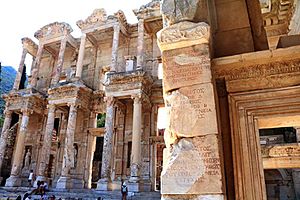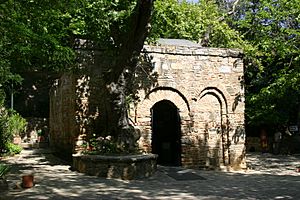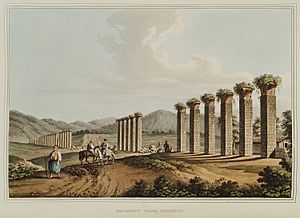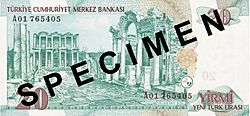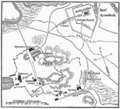Ephesus facts for kids
Ephesus (pronounced EFF-eh-sus) was a very old Greek city located on the western coast of what is now Turkey. It was a major city in ancient times and part of a group of twelve important cities called the Ionian League. The Apostle Paul from the Bible is believed to have written a letter to the Christians living there, which is now known as the Epistle to the Ephesians in the New Testament. Today, you can still see many well-preserved Roman ruins at the site, showing its rich history.
Some of the most amazing buildings in Ephesus include the odeon, which was a small theatre used for concerts and city meetings. It could hold about 1,500 people. There's also the Temple of Hadrian, built in the 100s AD, known for its beautiful sculptures. Curetes Street is a marble-paved road lined with many monuments and columns. You can also see a fountain dedicated to Emperor Trajan. A remaining part of a statue there shows that Romans knew the Earth was round even in the first century AD! The ancient public toilets (latrines) also show how much they cared about public health.
Two other incredible monuments in Ephesus are important not just for the city, but for the whole world's history and architecture. The first is the Library of Celsus, found at the end of Curetes Street. From the outside, it looks like a two-story building, but it actually had three stories inside. Its front is incredibly detailed and shows amazing craftsmanship. This library was the third largest in the ancient world, after the libraries in Alexandria and Pergamon. When you stand in front of this huge building, you can understand why it took 20 years to build (from 115 AD to 135 AD).
The second major monument is Ephesus's grand theatre. It was huge, big enough for 25,000 people! This wasn't just a place for plays; it was also used for animal fights and gladiator battles. Its massive size makes you feel how small a moment in time really is. According to the Bible (Acts 19:23-41), this theatre was where a big riot happened. Silversmiths who made silver statues of Artemis, the city's goddess, got angry because Paul's preaching was hurting their business. In the 1st century AD, the Apostle Paul spent over three years in Ephesus and often spoke in this theatre, telling people not to worship pagan gods.
Contents
Ephesus and Early Christianity
Ephesus became a very important center for Early Christianity starting in the 50s AD. From AD 52 to 54, the apostle Paul lived in Ephesus. He worked with the local Christian community and helped spread Christianity to nearby areas. At first, Paul went to the Jewish synagogue in Ephesus. But after three months, some Jewish people were stubborn, so he moved his teaching to the school of Tyrannus (Acts 19:9). This suggests that many people, including some Jews, became Christians in Ephesus.
Paul also met about twelve men who had only been baptized by John the Baptist. Paul then introduced them to the 'baptism with the Holy Spirit' (Acts 19:1-7). Later, Paul had a big disagreement with artisans who made money selling small statues of Artemis (also called Diana) at her temple (Acts 19:23-41). Between 53 and 57 AD, Paul wrote the letter called 1 Corinthians from Ephesus. He might have been in prison for a short time near the harbor when he wrote it. Later, Paul wrote the Epistle to the Ephesians while he was in prison in Rome, around 62 AD.
The region of Roman Asia, where Ephesus was located, was connected to John, one of Jesus's main followers. The Gospel of John might have been written in Ephesus around 90–100 AD. Ephesus was also one of the seven cities mentioned in the Book of Revelation, which shows that the church there was strong and important.
About 20 years later, the church in Ephesus was still important enough to receive a letter from Bishop Ignatius of Antioch in the early 2nd century AD. He praised the church in Ephesus for supporting him when he was taken to Rome for execution.
A story, first mentioned in the 300s AD, says that Mary, the mother of Jesus, might have spent her last years in Ephesus. This idea came from the fact that John was in the city, and Jesus had told John to take care of Mary after his death. However, some historians pointed out that the Bible says John went to Asia, but it doesn't specifically say Mary went with him. Since the 1800s, a place called The House of the Virgin Mary, about 7 kilometers (4 miles) from Selçuk, has been thought to be Mary's last home. This belief comes from the visions of Sister Anne Catherine Emmerich. It is now a popular place for Catholic pilgrimages, and three recent popes have visited it.
The Church of Mary near the harbor of Ephesus was the location of an important meeting called the First Council of Ephesus in 431 AD. At this meeting, a religious leader named Nestorius was condemned. Another council was held in Ephesus in 449 AD, but its decisions were not accepted by Catholics and it was called the Robber Council.
Main Ancient Sites
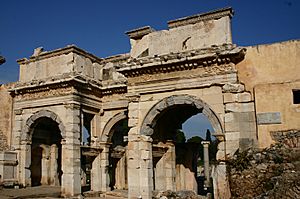

Ephesus is one of the largest Roman archaeological sites in the eastern Mediterranean Sea. The ruins you can see today still give you an idea of how grand the city once was. The theatre is the most striking view when you look down Harbour Street, which once led to the city's port (now filled with silt).
Temple of Artemis
The Temple of Artemis was one of the Seven Wonders of the Ancient World. It was once a massive building, about 127 meters (418 feet) long and 73 meters (239 feet) wide, with over 100 marble pillars, each 17 meters (56 feet) tall. This temple gave Ephesus the nickname "Servant of the Goddess." It took 120 years to build this magnificent structure. Today, only one small column remains, found during an archaeological dig in the 1870s. Some pieces of its decoration and other small finds were taken to London and the Archaeological Museum in Istanbul.
Library of Celsus
The Library of Celsus has had its front carefully rebuilt using original pieces. It was built around 125 AD to honor Tiberius Julius Celsus Polemaeanus. He was an Ancient Greek who served as governor of Roman Asia from 105 to 107 AD. Celsus paid for the library's construction with his own money and is buried in a special stone coffin beneath it. His son, Gaius Julius Aquila, mostly built the library, which once held nearly 12,000 scrolls. The building was designed with a grand entrance to make it look even bigger. It faces east so that the reading rooms could get the best morning light.
The Grand Theatre
With an estimated 25,000 seating capacity, the theatre is believed to be the largest in the ancient world. This open-air theatre was first used for plays. But in later Roman times, gladiator fights were also held on its stage. The first archaeological proof of a gladiator graveyard was found here in May 2007.
Other Important Structures
Ephesus had two agoras, which were public gathering places. One was for business and trade, and the other for government matters. The city also had several large bath complexes, built at different times during Roman rule.
The city had one of the most advanced aqueduct systems in the ancient world. At least six aqueducts of different sizes brought water to various parts of the city. They also supplied water to several water mills, including one that was a sawmill for cutting marble.
The Odeon was a smaller, roofed theatre built around 150 AD. It was a cozy place for plays and concerts, seating about 1,500 people. It had 22 steps, and its upper part was decorated with red granite pillars.
The Temple of Hadrian was built in the 2nd century. It was repaired in the 4th century and has been put back together using the pieces that survived. The carvings in the upper sections are copies, with the originals displayed in the Ephesus Archaeological Museum. These carvings show figures like Emperor Theodosius I with his wife and oldest son.
The Temple of the Sebastoi (sometimes called the Temple of Domitian) was one of the city's largest temples. It was dedicated to the Flavian dynasty of Roman emperors.
The Tomb/Fountain of Pollio was built in 97 AD to honor C. Sextilius Pollio. He built the Marnas aqueduct, which brought water to the city.
A part of the site, the Basilica of St. John, was built in the 6th century AD under Emperor Justinian I. It was built over what is believed to be the tomb of the apostle John. Today, it is surrounded by the modern town of Selçuk.
The Seven Sleepers
Ephesus is believed to be the city of the Seven Sleepers. This famous story tells of seven young men who were persecuted for their belief in one God. They are said to have slept in a cave near Ephesus for centuries. This story is important to both Catholics and Orthodox Christians, and it is also mentioned in the Qur'an.
Images for kids
-
Site of the Temple of Artemis in the town of Selçuk, near Ephesus.
-
The Temple of Hadrian
See also
 In Spanish: Éfeso para niños
In Spanish: Éfeso para niños


